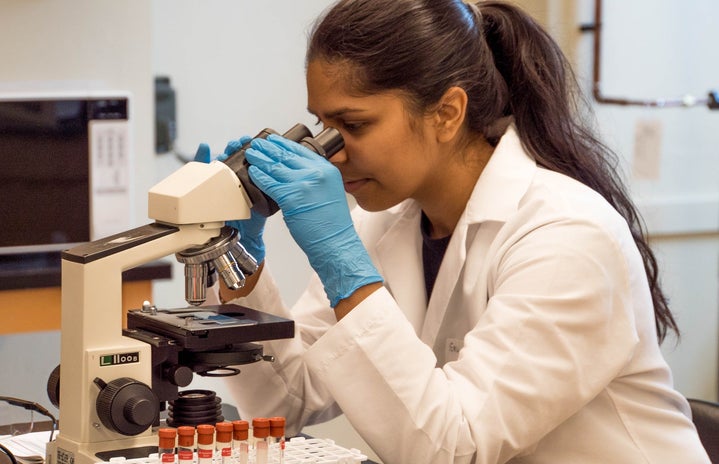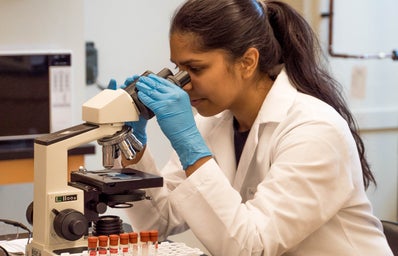Despite making up a comfortable majority, women are still failing to fill classrooms in life sciences, mathematics, and graduate research at the University of St Andrews. Computer science and physics have ratios of 4-to-1 for men to women; there is also a discrepancy between gender ratios in undergraduate degrees, and those in positions of power, which disproportionately favours men. Upcoming society Women in STEM (WIS) is now seeking to provide a social and career-focused community for those in the respective degrees.
President and founder Carlotta Löer remembers being confused by the lack of a female sciences community in the university. The university’s longer-running society, Women in Computer Science (WICS), provides a platform for those wanting to get further insights into programming. WICS has a large amount of resources and connections with software companies, and provides nighttime programming classes as well as socials. As a second year student studying neuroscience, Carlotta believes WICS is important but cannot address the unique struggles of other science degrees. “We’re hoping to collaborate [with WICS]. They have a lot of valuable insight, but it is only centred around computer science.”
Treasurer and Vice President Sophia Caton, who studies environmental earth science, sees the issues found in fieldwork degrees as particularly unique. “Fieldwork-based STEM has historically been very challenging or dangerous for women,” she says. “Statistics for sexual harassment have been really high, this is a conversation that can be had in Women in STEM. And it’s not necessarily the same for computer science, or some other sciences. This is why Women in STEM is so important as a broader base.”
For women in fieldwork, there is a higher risk to working in a remote research camp as opposed to a traditional lab. Spaces like remote camps expose women to higher rates of harassment, discrimination, and social isolation. Sophia also acknowledges the need for women in fieldwork to diversify research. “A lot of science has been done by men and you see the results of that, there’s a lot of potential research which isn’t done for female diseases or anatomy because men don’t think to do it,” she says. “The more women that get into the fieldwork, the ball will eventually start rolling. If women keep getting forced out of fieldwork they will never feel comfortable contributing to it.” Many biology and earth science research camps are in particularly remote areas — an arctic base, for example, or a sparsely populated island. In 2021, the United States Antarctic Program (USAP) launched a report on harassment prevention, in response to recent allegations and petitions for greater protection.
Women in STEM acknowledges the variety of issues facing women in the sciences. Regardless of subtle differences between risk in fieldwork and a computer lab, there is a common difficulty breaking into fields traditionally dominated by men. As a student progresses from undergraduate to masters, and eventually to research and positions of management, the proportion of women to men decreases.
In response, WIS hopes to provide a community which is welcoming to women and non-binary students pursuing STEM degrees, whilst further educating on potential career paths. President Löer describes how WIS is helpful to students: “Though there are a lot of women in undergrad STEM, we’re very aware the numbers will begin to decline… This can be isolating. We’re planning on hosting PhD panels, so people know what to expect — especially in paths without the best gender balance.”
Aside from educating on future career plans, and hearing from women who went through an education system for science degrees, Women in STEM holds socials to further the current community. Made up of mostly undergraduates, the society’s events range from bonfires to coffee breaks. “The best event was the pub quiz. A lot of people turned up, it was really successful,” says Amelia Green, secretary and a second-year computer science student at St Andrews. “We’re hoping to do more events like this in the future, so everyone gets to know each other.”
Women in STEM’s events are an opportunity to relax, but also discuss the implications of being a woman studying a sciences degree. The society is also open to non-binary students, and stresses an open community for those in STEM. Labs and programming culture can often be alienating, specifically for women. Secretary Green sees this as detrimental, but also motivation to encourage other women to stay in STEM. “There’s the intimidation of going into a field without that many women,” she says. “But that also has that incentive of breaking the glass ceiling… it serves as a motivation to work even harder.”
Communities like Women in STEM are important to creating an open environment for students. At the University of St Andrews, WIS plans to establish itself as open to undergraduates and graduates studying STEM, who may be looking for a place to meet like-minded students. The society will also fill a meaningful role in providing resources for career paths in STEM, in the context of the historical absence of a female community in the sciences.

